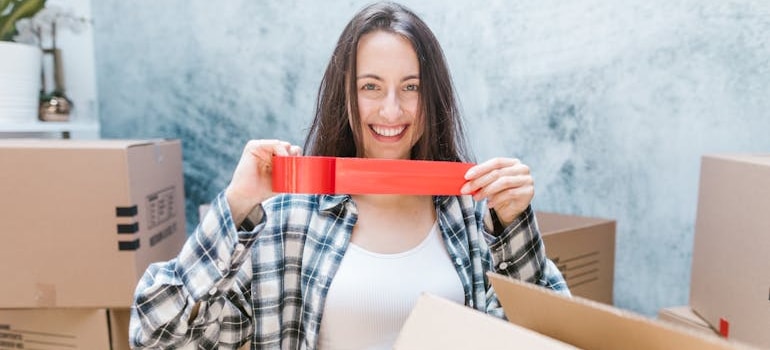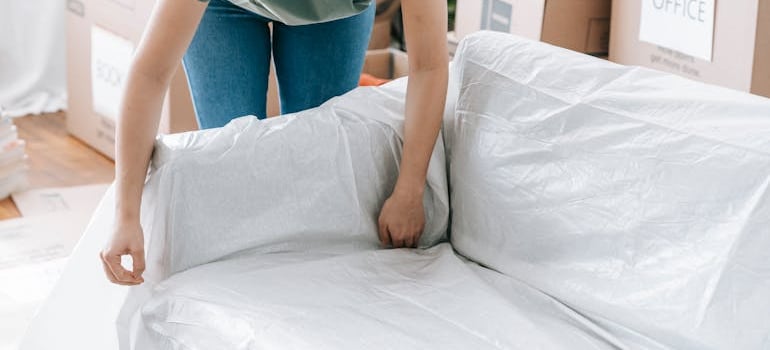Packing Materials for a Safe International Move

Get a Free Moving Quote Now!
Start Your International Moving Journey






Getting ready for an international move is a huge job that involves a lot of planning and the most important thing is to keep your most important things safe over thousands of miles. Choosing a trustworthy mover is just as important as knowing what packing supplies you’ll need for your international move.
You may think the containers and packaging you use for shipping are not a big deal but, we assure you, they’re one of the most important investments you can make to protect your items against wear and tear that inevitably occurs during long hauls, when goods will be handled by many agents numerous times and endure temperature changes as well as sit in storage for quite a while.
The Foundation: Choosing and Using Sturdy Boxes
The only way to move internationally is to use strong, purpose-built boxes. Flimsy, used grocery boxes are only good for light items and short-term use. They can’t handle the stacking, shifting, and possible exposure to moisture that an ocean or air freight container can.
Why Specialty Moving Boxes are Non-Negotiable?
Boxes are made with double-wall, C flute corrugated to give excellent package strength. This kind of durability is critical for an international move, during which your container is likely to be on the open water for weeks.
And uniform box sizes are not just about tidy-ness; they ensure sturdy, evenly-stacked packages inside the shipping container, and thus avoid of collapses which would squish your merchandise. Random-sized boxes mean you end up with lots of dead space and an unstable stack that costs you more in the long run.
For the very heaviest things — say, books or cast-iron cookware or tools — you can buy there’s a more robust version that has even thicker walls and more heavy-duty construction.
A Box for Every Purpose

- Small Boxes: Perfect for high-soar valuable objects such as books, records and canned goods. Keeping them compact also prevents the box from becoming too heavy to handle safely and reduces the risk of the bottom giving way.
- Medium & Large Boxes: Ideal for bulky items, such as linens, pillows and clothing.
- Specialty Boxes: For organization and protection, these are a klutz’s treasure!
- Dish-Packs: These are double-walled boxes that are extra thick. They often have cell dividers that make separate spaces for plates, bowls, and platters so they don’t bang into each other.
- Wardrobe Boxes: These let you move your hanging clothes straight from your home closet to your new closet abroad, so you don’t have to iron and re-hang everything.
- Picture/Mirror Boxes: Picture and mirror boxes are long and narrow boxes made just for framed art, mirrors, and big flat-screen TVs. They protect the corners and edges of these items.
Sourcing Boxes
Always source your boxes from a reputable moving company or packing supplier. They will offer materials rated for international shipping. Using boxes provided by your international mover also often comes with the assurance that they are clean, dry, and free from pests, which is a critical requirement for passing agricultural customs inspections in many countries.
The Cushioning Core: Mastering Packing Paper, Bubble Wrap, and Beyond
Fragile items demand a cocoon of protective cushioning. The goal is to eliminate all internal movement within the box and absorb any external shocks.
Packing Paper
For Moving Packing Paper and Bubble Wrap are perfect for protecting any of your breakable items. It’s also a versatile, all-purpose option ideal for wrapping glassware and images or non-precise surfaces. What’s great about it is that there’s no ink involved, so you don’t have to worry about staining any of your things.
The professional technique is to crumple sheets loosely to create air pockets, providing superior cushioning compared to simply laying the paper flat. It is also excellent for stuffing empty spaces within boxes (a process known as “void-filling”) to stop items from shifting.
Bubble Wrap
This high-impact foam padding is ideal for electronics, china, delicate glass and more. ★ For #1 Best protection – BE SURE to place the bubble side facing the item and NOT the other way around. It is the air that gets stuck in between them which provides the cushion.
Use a double layer of bubble wrap or larger, “anti-static” bubble wrap made for electronics to keep static electricity from building up and hurting sensitive circuits.
Foam Wrap & Foam Sheets
For those items with very delicate finishes such as polished wood, antique furniture and high gloss finishes foam wrap is better than bubble wrap as it does not leave any marks on the surface.
Eco-Friendly Alternatives
Great sustainable options also exist for the eco-friendly mover. These are comprised of shredded recycled paper padding, biodegradable air pillows crafted from corn starch and even packaging made from mushrooms.
“Anyone with respiratory challenges or sensitivities would do well to consider this when choosing a “green” moving material, but you should discuss it with your mover in advance because some elements (like organic materials) may be restricted from going to certain international destinations.”
The Unbreakable Seal: The Critical Role of Heavy-Duty Packing Tape
A box is only as safe as the tape that closes it. Anything flimsy tears and is a no-go: masking tape, Scotch tape.
Why Heavy-Duty Tape is Essential?
You want a shipping tape that is really meant for sealing boxes, it has to be high performance. You want something that’s at least 2 inches (48-55 mm) wide and has a high tensile strength.
Your best bet for securing strength is with hot melt tape, an adhesive that is rubber-based and makes immediate strong contact to the cardboard’s fibers. It works well over an extensive temperature range — important in the context of containers that can encounter both extreme heat and cold along the way.

Proper Taping Technique
- Use a tape dispenser for speed and a clean, straight application.
- Tape the bottom seam of the box first — it’s commonly one of the weakest points.
- Follow the “H-Pattern” method: secure tape on the middle seam of box flaps, then apply a second piece perpendicular to it — you’re forming a strong “H” swiftly adhered to the bottom and top of your box. This holds all the flaps in place.
- For very heavy boxes, consider reinforcing the edges and seams with extra tape.
Protecting the Big Pieces: Furniture Covers, Moving Blankets, and Padded Protection
Sofas, tables, mattresses and other large items are especially prone to getting scratched, dented or dirtied in transit.
Moving Blankets
These are bulky, padded pads designed to cover and protect wooden furniture, appliances or electronic equipment. Professional moving blankets are usually composed of a mix of synthetic materials and meant to be shock-resistant as well as long lasting.
They can be fastened with twine or shrink wrap. For an international move, use new blankets or make sure rented ones are spotlessly clean so dust and bugs aren’t dropped off with your things at the shipping container.

Furniture Covers
For top-quality protection for your precious upholstered furniture, we offer fitted canvas or ultra-breathable polypropylene. They shield against dust, moisture and scratches.
Stretch Wrap (Plastic Wrap)
This is I believe indispensable tool to protect furniture. Wrapping a dresser or bookshelf tightly protects all drawers and doors from sliding open (and causing damage!) It also has a protective guard to shield from scuffs and liquid spills. If for carpet, Place under the plastic protector a soft cloth or foam pad to avoid sticking of the plastic & damaging Finish on wooden furniture.
The Organizer’s Arsenal: Zip lock Bags, Plastic Wrap, and Small Item Management
The chaos of a move is often cantered on the multitude of small parts and items. Keeping these organized is key to a smooth unpacking experience.
Zip lock Bags (Various Sizes)
These are perfect for creating “parts kits.”
- Use them to bag all the screws, bolts, and brackets from disassembled furniture and tape the bag directly to the item it belongs to.
- Use them for organizing cables and chargers, labelling each bag clearly (e.g., “Kitchen TV,” “Office Monitor”).
- They’re also great to prevent leaks from toiletries, shampoos and cleaning supplies. Tape the first cap that came with it, then zip lock bag.
Stretch Wrap
Beyond furniture, use it to bundle together items like curtain rods, table legs, or rugs rolled with their pads.
The Master Key to a Smooth Transition: Labels, Markers, and Inventory Lists
This is perhaps the single most important thing that you need to do to keep your mind uncluttered and ensure you respect international shipping rules.
- Waterproof Markers: Imagine a permanent marker with a large tip that won’t smudge when moist. Make sure all of the boxes have at least 2 sides that are properly labeled.
- Color-Coded Labels: Designate a different color of duct tape or sticker for each room in your new home (green for the kitchen, say, and blue for the master bedroom). Place the matching color sticker on each box that belongs in a given room. That way, when movers who don’t speak your language show up, the boxes can be placed in their proper room quickly and accurately.
- Detailed Inventory List: Everything in it and where it belongs, so you can get through customs as quickly as possible. This will come in very handy should you need to file an insurance claim if something goes wrong and you lose your possessions.
- It provides the basis for your moving insurance claim should any damage occur.
- It may be required by customs officials to assess duties.
- It allows you to quickly identify if a box has gone missing. Taking photographs or a short video of the contents of high-value boxes provides even stronger evidence for insurance purposes.
- Numbered Boxes: Label boxes with numbers matching the inventory list to avoid confusion during unpacking.
Tags that say “This Side Up” and “Fragile”: Feel free to slather your boxes in these tags, and make them big. Not simply “Fragile,” but whatever’s inside, like “FRAGILE: GLASSWARE & DISHES” or “FRAGILE: ELECTRONICS.”
These are critical for organizing your things and easy finding of them when you move abroad.
Going the Extra Mile: Specialty Packing for High-Value and Delicate Items
Standard packing materials are not sufficient for heirlooms, fine art, and sensitive electronics. These items require a bespoke approach.
Custom Crating
The best way to transport extremely valuable, heavy, or oddly shaped things like grand pianos, sculptures, or antique furniture is to use a professional crating service that creates personal-sized wood crates for your items. These are crates designed to carry a lot of weight and take direct hits.
On the inside, the product is hung in place with high-density foam blocks, brackets and straps securing it so that there’s no possibility of movement or damage from any accident occurring to the outer crate.
Picture/Mirror Boxes with Corner Protectors
As mentioned, these specialty boxes are a must. For added security, use rigid foam corner protectors before placing the item in the box.
Climate-Controlled Storage
If you’re unable to move in right then and there, you could be forced to put all your stuff in storage and lose access to your new home for a period of time. Day-to-day storage isn’t safe for items, such as wood instruments or artwork, that are sensitive to temperature and humidity.
Climate-controlled storage warehouses maintain a constant, comfortable temperature and humidity level year round. It’s what prevents wood from warping, canvas from cracking and metal from rusting. This is something you should always request when moving overseas with anything valuable or private.
Conclusion: Invest in Protection for Total Peace of Mind During Overseas Moving
The process of gathering the right packing supplies for your international move is a direct investment in the safety of your worldly possessions and your own peace of mind. Cutting corners on materials is a significant risk that can lead to heartbreak and financial loss upon delivery.
A DIY is feasible, but it’s bloody hard work. That’s why a little professional know-how goes a long way.
At International Air & Sea Shipping we don’t just offer boxes and tape, we provide professional, worry-free packing services. We ensure with the packaging services our teams are equipped with the most advanced packing methods and materials which protect your valuable goods from environmental hazards, make certain to provide necessary protection for our customers.- Cargo Our friendly staff at AMJ Overseas will also schedule a series of container deliveries to meet your needs for shipping that is professional and responsible.
Do not rely on luck to keep your valuables secure. We will deal with the difficult matters so you can concentrate on enjoying your new life overseas.
Give us a ring today for a no-obligation quote and advice on how we can get you moving. We’re able to create a packing plan that ensures not only does your stuff get sent off, but it is cared for and loved en route.
FAQ’s
Can I use suitcases for moving instead of boxes?
Yes, for hardy non-delicate items like books and shoes, suitcases can’t be beat. But the latter are not suitable for packing into a sea container in secure conditions: they do not have standard shape. Industrial rated boxes are perfect for the highest quality safety and space-saving.
How to get my mattresses ready for an international move?
This can be avoided by using only a specially designed mattress bag or cover. These are heavy plastic bags to protect from dirt, dust and moisture. Never use regular plastic wrap to cover a mattress on its own because this will help trap moisture within the mattress and promote mold development.
Do I need to clean my appliances before moving them?
Yes. ANY goods such as fridges, washing machines, ovens etc must be thoroughly clean and 100% dry otherwise they will not be allowed to enter New Zealand and may have an adverse impact on the customs requirements. After cleaning, seal moving parts with tape.
What can I not pack when moving internationally?
Yes. And, of course, there is a prohibition everywhere on bringing hazardous goods to ship internationally or disposing of them in landfills. This encompasses aerosols, paint, gasoline, some cleaning supplies and perishable foods. Be sure to ask your mover for a full listing of restricted commodities.
Are professional packing services worth it?
It can be a good investment for an international move, which is more complicated. Professionals have better materials and techniques, minimize risk of damage, and much of their work is covered by insurance – giving you peace of mind, not to mention saving the time and hassle.
